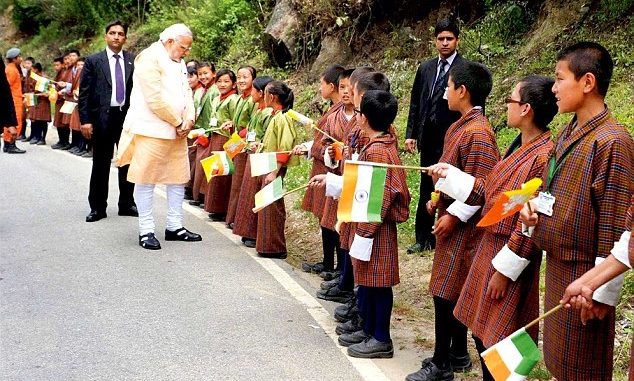
Prime Minister Narendra Modi’s Bhutan visit.
- PM Modi urged for a greater degree of cooperation between the two nations in the areas of Health, Space and Education.
- Students from Bhutan were invited for studies in India in various subjects ranging from Buddhism to space.
- India’s commitment to enhance Bhutan’s space technology was underlined by the inauguration of the Ground Earth Station and SATCOM network (developed by the assistance of ISRO) by the leaders of both countries.
- PM Modi added that India Bhutan ties should outgrow the traditional hydro power and energy areas and mutual cooperation should be achieved in newer areas like digital payments and disaster management.
- PM modi inaugurated Mangdechhu Hydropower project with the energy generating capacity of 720 MW.
A Background of India Bhutan Relations:
- The history of India-Bhutan relations goes back to the colonial era. During the British rule, Bhutan was a protectorate of British India (by the treaty of 1910) and its foreign policy and defence were guided by the British.
- Bhutan was the first country to recognize Indian Independence in 1947 and the relations between the two were strengthened by the Annexation of Tibet (in 1950) by the Republic of China.
- A treaty of cooperation was signed by Indian and Bhutan in 1949 which outlined the bilateral relations between both countries. The treaty of cooperation of 1949 provided for the requirement of India’s guidance in Bhutan’s foreign policy, has been revised by the treaty of 2007. The new treaty of 2007, considering the sovereignty of Bhutan replaced this provision.
- Relations between Bhutan and India were previously looked after by India’s Political Officer in Sikkim. In 1968, diplomatic relations between the two countries were founded by the setting up of a special officer in Bhutan.
Contemporary relations between India and Bhutan:
- India is Bhutan’s largest trade partner with over 80 percent of its exports and more than 90 percent of imports every year.
- Mechanical appliances, Vehicles, Electrical equipments, Mineral Products and vegetables are major imports by Bhutan from India.
- Cement clinkers, dolomite, electricity, portland cement and ferro silicon are the major exports of Bhutan to India.
Water Resources:
- India and Bhutan have a joint management system called Joint Group of Experts (JGE) for flood management and to assess the causes of frequent floods and issues related to soil erosion in the foothills of Himalaya
On Cultural and Educational Front:
- The uniqueness of India-Bhutan relations lies in their traditional intimacy of their cultures. A large chunk of Bhutanese students come to India for studies. Many under-graduate and postgraduate scholarships like Nehru-Wangchuk scholarship and Ambassador’s scholarship are offered to Bhutanese students studying in India.
Geographical Importance:
- Although India and Bhutan share close cultural bonds and strong trade ties, the geographical location of Bhutan servers as the X factor in their cooperation. Bhutan is located between India and China, the two Asian giants, which makes it a buffer state for them.
- Notably, Buffer state is a country which lies between two adversary powers. The existence of a Buffer state between two greater superpowers prevents a full grown conflict between the two counties. Interestingly, buffer states are very prone to be occupied by either of the greater powers to exert a geographical pressure on the other country.
- Since India and Bhutan share a special relations and Bhutan being a Protected State of India, India has considerable influence over Bhutan’s foreign affairs. This provides a great deal of geopolitical edge to India over China, our nemesis. Chines annexation of Tibet in1951 and the Doklam stand off between India and China are the notable examples.
The untapped Hydro Power Potential:
- Bhutan provides a large amount of inexpensive and clean hydro energy to India and generates a tremendous export revenue from it in return. India has developed three major hydro power project in Bhutan generating total energy of 1416 MW. In the recent visit PM modi inaugurated Mangdechhu Hydropower project in Bhutan.
- Despite serving cheap electricity to India, Bhutan’s true hydropower potential has not yet been explored. Bhutan has been estimated to contain around 30,000 Megawatts (MW) of energy out of which 27,000 MW is economically feasible. The yet explored energy amounts a very tiny fraction of the potential which is 1615 MW.
- In 2003-04, anti-India insurgents of the United Liberation Front of Assam which was based on the territory of Bhutan to attack India were driven off by the Royal Bhutanese Army.
Conclusion:
- The visit of Prime Minister Narendra Modi marked as an essential step to restore bilateral relations between India and Bhutan. Bhutan’s worry of too much trade and tourism with India is understandable as it could jeopardise the environment.
- Further, new generation of Bhutanese students are not restricted to India for their studies. The relations should not be taken for granted, the high level visits from the U.S and China are alerting signs for India to maintain its strategic relations with Bhutan

Leave a Reply
You must be logged in to post a comment.